Experimental Verification of a Highly Simplified, Preliminary Machinability Test for Wood-Based Boards in the Case of Drilling
Abstract
:1. Introduction
2. Materials and Methods
3. Results and Discussion
4. Conclusions
Author Contributions
Funding
Data Availability Statement
Conflicts of Interest
References
- Zahedi, M.; Najafi, S.K.; Füssl, J.; Elyasi, M. Characterization of engineering elastic parameters of oriented strand board (OSB) manufactured from poplar (Populus deltoides) strands using ultrasonic contact pulse transmission. Drv. Ind. 2020, 71, 227–234. [Google Scholar] [CrossRef]
- Cai, Z.; Senalik, C.A.; Ross, R.J. Mechanical Properties of Wood-Based Composite Materials. In Wood Handbook—Wood as an Engineering Material; General Technical Report FPL-GTR-282; Department of Agriculture, Forest Service, Forest Products Laboratory: Madison, WI, USA, 2021; Chapter 12; p. 15. [Google Scholar]
- Wang, J.; Cao, X.; Liu, H. A review of the long-term effects of humidity on the mechanical properties of wood and wood-based products. Eur. J. Wood Prod. 2021, 79, 245–259. [Google Scholar] [CrossRef]
- Magalhães, R.; Nogueira, B.; Costa, S.; Paiva, N.; Ferra, J.M.; Magalhães, F.D.; Martins, J.; Carvalho, L.H. Effect of panel moisture content on internal bond strength and thickness swelling of medium density fiberboard. Polymers 2021, 13, 114. [Google Scholar] [CrossRef]
- Karaman, A.; Balcioglu, H.E. An Investigation of flexural behavior of pure and hybrid wood composite panels using weibull analyses. Drv. Ind. 2021, 72, 201–210. [Google Scholar] [CrossRef]
- Papadopoulos, A.N. Advances in wood composites. Polymers 2019, 12, 48. [Google Scholar] [CrossRef] [Green Version]
- Nazerian, M.; Nanaii, H.A.; Vatankhah, E.; Koosha, M. Performance of ANN in predicting internal bonding of cement particleboard manufactured from giant reed and bagasse. Drv. Ind. 2021, 72, 255–271. [Google Scholar] [CrossRef]
- Klímek, P.; Wimmer, R.; Meinlschmidt, P. TOF-SIMS molecular imaging and properties of pMDI-Bonded particleboards made from cup-plant and wood. Appl. Sci. 2021, 11, 1604. [Google Scholar] [CrossRef]
- Iždinský, J.; Vidholdová, Z.; Reinprecht, L. Particleboards from recycled wood. Forests 2020, 11, 1166. [Google Scholar] [CrossRef]
- EN 320. Particleboards and Fibreboards. Determination of Resistance to Axial Withdrawal of Screws; European Committee for Standardization: Brussels, Belgium, 2011. [Google Scholar]
- Rogoziński, T.; Wilkowski, J.; Górski, J.; Czarniak, P.; Podziewski, P.; Szymanowski, K. Dust creation in CNC drilling of wood composites. Bioresources 2015, 10, 3657–3665. [Google Scholar] [CrossRef] [Green Version]
- Podziewski, P.; Szymanowski, K.; Górski, J.; Czarniak, P. Relative Machinability of Wood-Based Boards in the Case of Drilling–Experimental Study. Bioresources 2017, 13, 1761–1772. [Google Scholar] [CrossRef] [Green Version]
- Ferrandez-García, M.T.; Ferrandez-Garcia, A.; Garcia-Ortuño, T.; Ferrandez-Garcia, C.E.; Ferrandez-Villena, M. Assessment of the physical, mechanical and acoustic properties of arundo donax l. biomass in low pressure and temperature particleboards. Polymers 2020, 12, 1361. [Google Scholar] [CrossRef]
- Sudoł, E.; Kozikowska, E. Mechanical properties of polyurethane adhesive bonds in a mineral wool-based external thermal insulation composite system for timber frame buildings. Materials 2021, 14, 2527. [Google Scholar] [CrossRef]
- Górski, J.; Podziewski, P.; Szymanowski, K. Fundamentals of Experimental Studies of Wood and Wood Based Materials Machinability. In Wood Machining and Processing–Product and Tooling Quality Development; Górski, J., Zbieć, M., Eds.; WULS–Press: Warsaw, Poland, 2010. [Google Scholar]
- Šebelová, E.; Chladil, J. Tool wear and machinability of wood-based materials during machining process. Manuf. Technol. 2013, 13, 231–236. [Google Scholar] [CrossRef]
- Lin, R.J.; Van Houts, J.; Bhattacharyya, D. Machinability investigation of medium-density fibreboard. Holzforschung 2006, 60, 71–77. [Google Scholar] [CrossRef]
- Szwajka, K.; Trzepiecinski, T. On the machinability of medium density fiberboard by drilling. Bioresources 2018, 13, 8263–8278. [Google Scholar] [CrossRef]
- Wilkowski, J.; Borysiuk, P.; Górski, J.; Czarniak, P. Analysis of relative machinability indexes of wood particle boards bonded with waste thermoplastics. Drewno 2013, 56, 139–144. [Google Scholar] [CrossRef]
- Wilkowski, J.; Kozub, W.; Borysiuk, P.; Rousek, M.; Czarniak, P.; Górski, J.; Podziewski, P.; Szymanowski, K. Machinability of particleboards bonded with SBR gum granulate. Ann. Wars. Univ. Life Sci.-SGGW For. Wood Technol. 2014, 85, 230–234. [Google Scholar]
- Dagnell, J. Machinability ranking by a constant feed force method. Ann. CIRP 1969, 17, 233–242. [Google Scholar]
- Lindgren, B. Constant feed force machinability testing-further development and industrial applications. Ann. CIRP 1978, 27, 39–43. [Google Scholar]
- Kozana, J.; Rzadkosz, S.; Garbacz-Klempka, A.; Piekos, M.; Cieslak, W. The influence of selected alloying elements on the microstructure, selected mechanical and technological properties of brasses. Metall. Foundry Eng. 2013, 39, 37–46. [Google Scholar] [CrossRef] [Green Version]
- Rzadkosz, S.; Kozana, J.; Garbacz-Klempka, A.; Piękoś, M. Structure analysis and properties of unleaded brasses. Arch. Met. Mater. 2015, 60, 323–328. [Google Scholar] [CrossRef] [Green Version]
- Manole, V.; Slătineanu, L.; Olaru, S.C.; Beşliu, I.; Iurea, P.; Gonçalves-Coelho, A. Results of an experimental research concerning the evaluation of machinability by drilling under constant feed force. Appl. Mech. Mater. 2015, 809–810, 147–152. [Google Scholar] [CrossRef]
- EN 312. Particleboards–Specification; European Committee for Standardization: Brussels, Belgium, 2010. [Google Scholar]
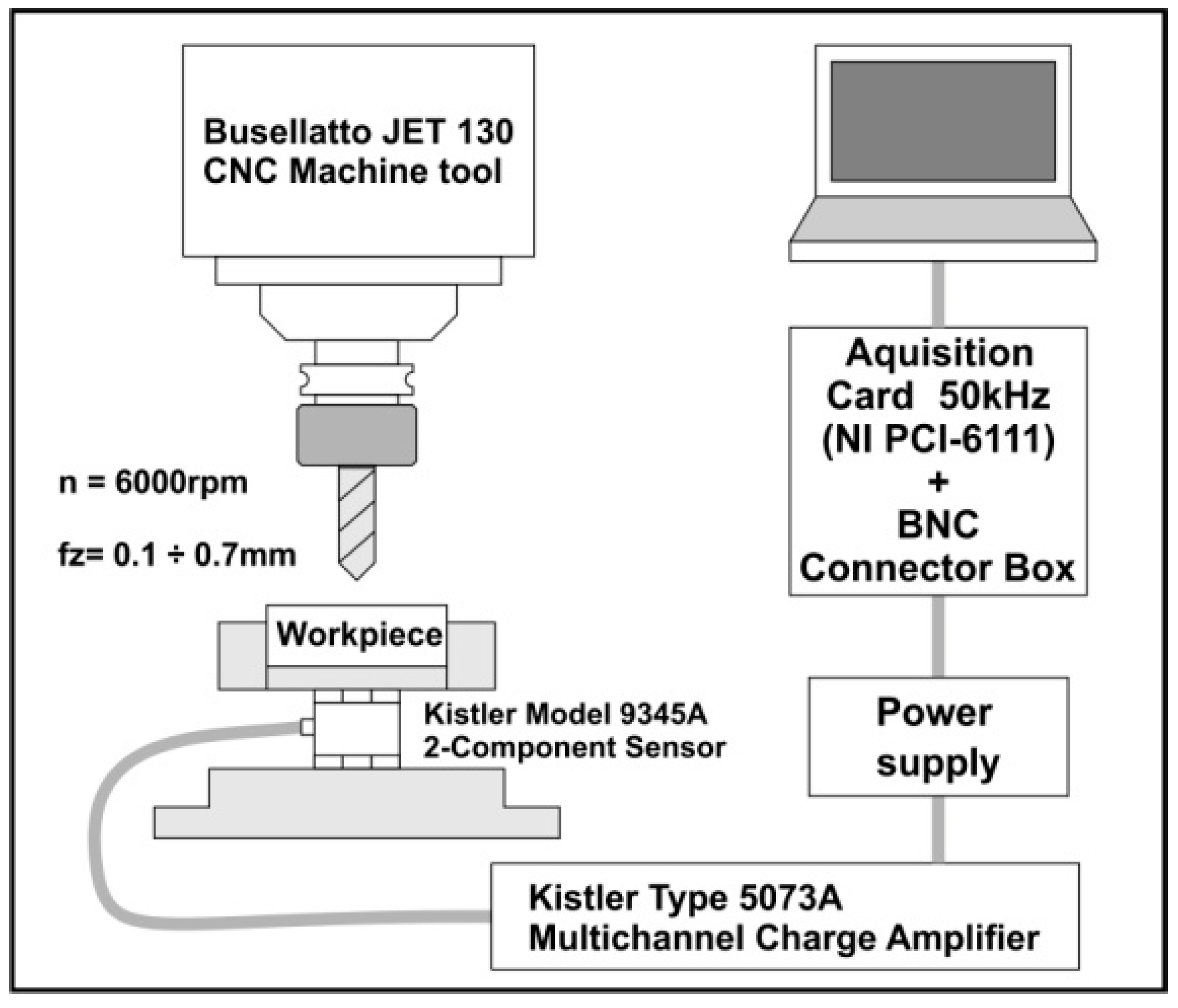
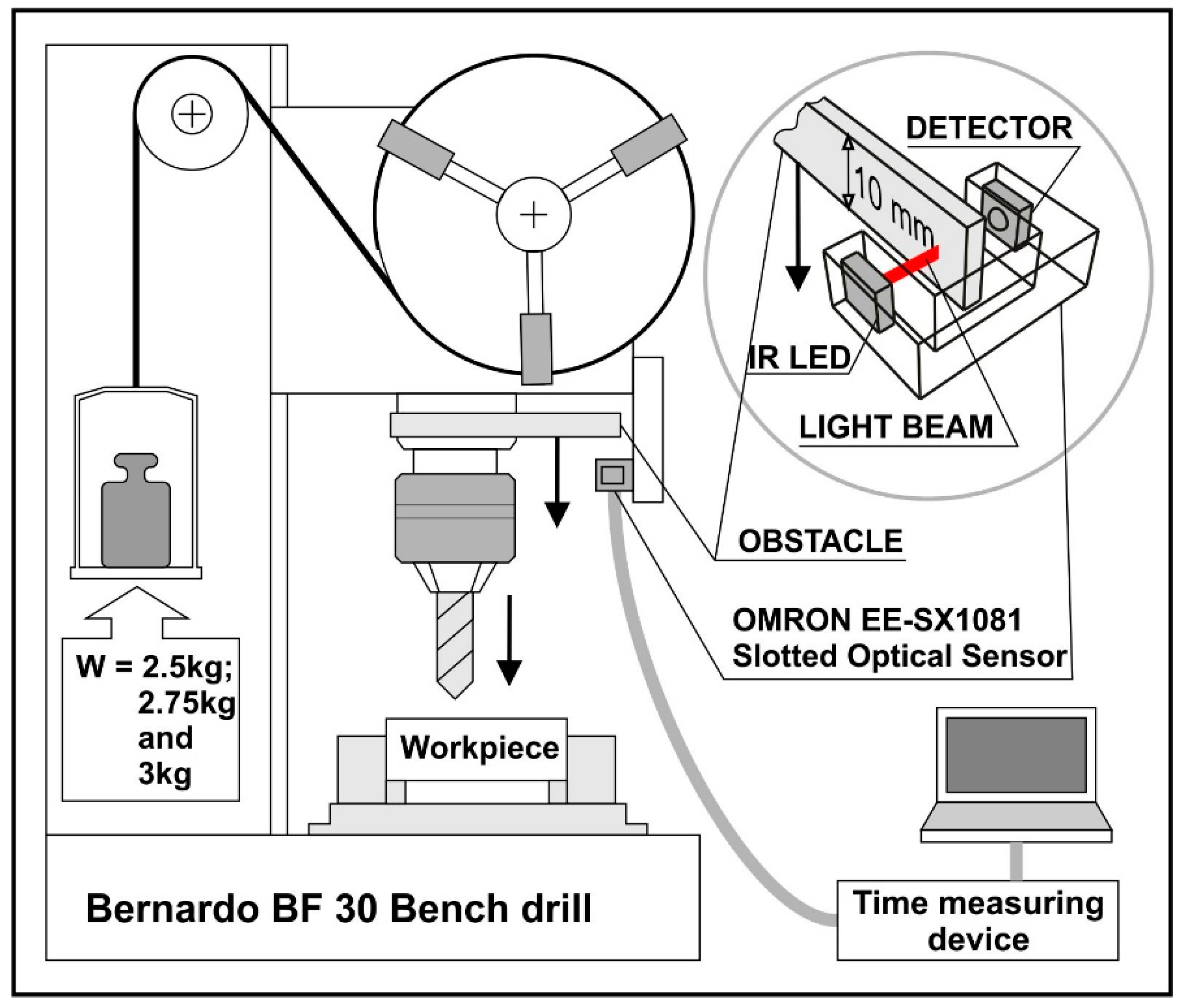
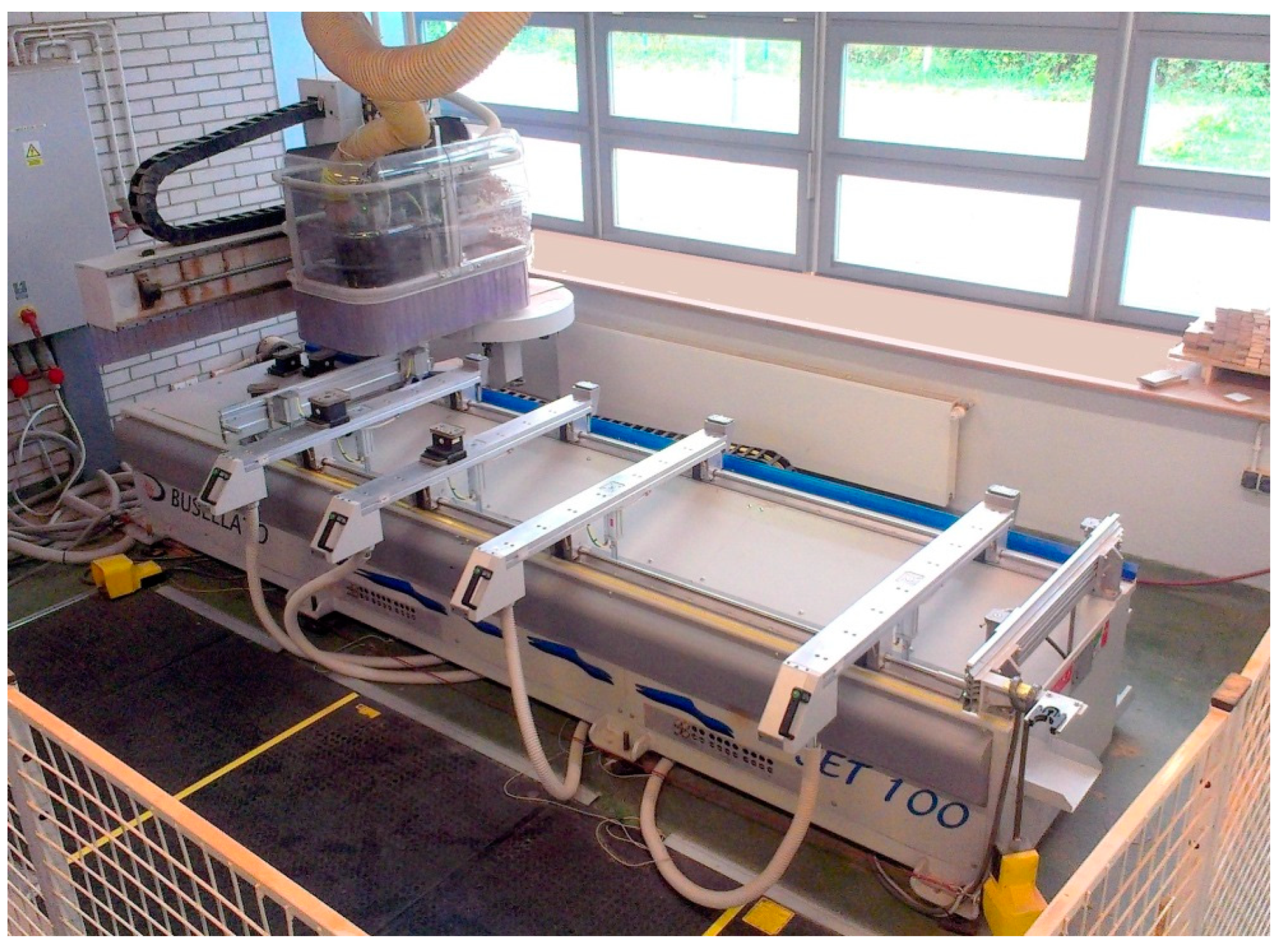



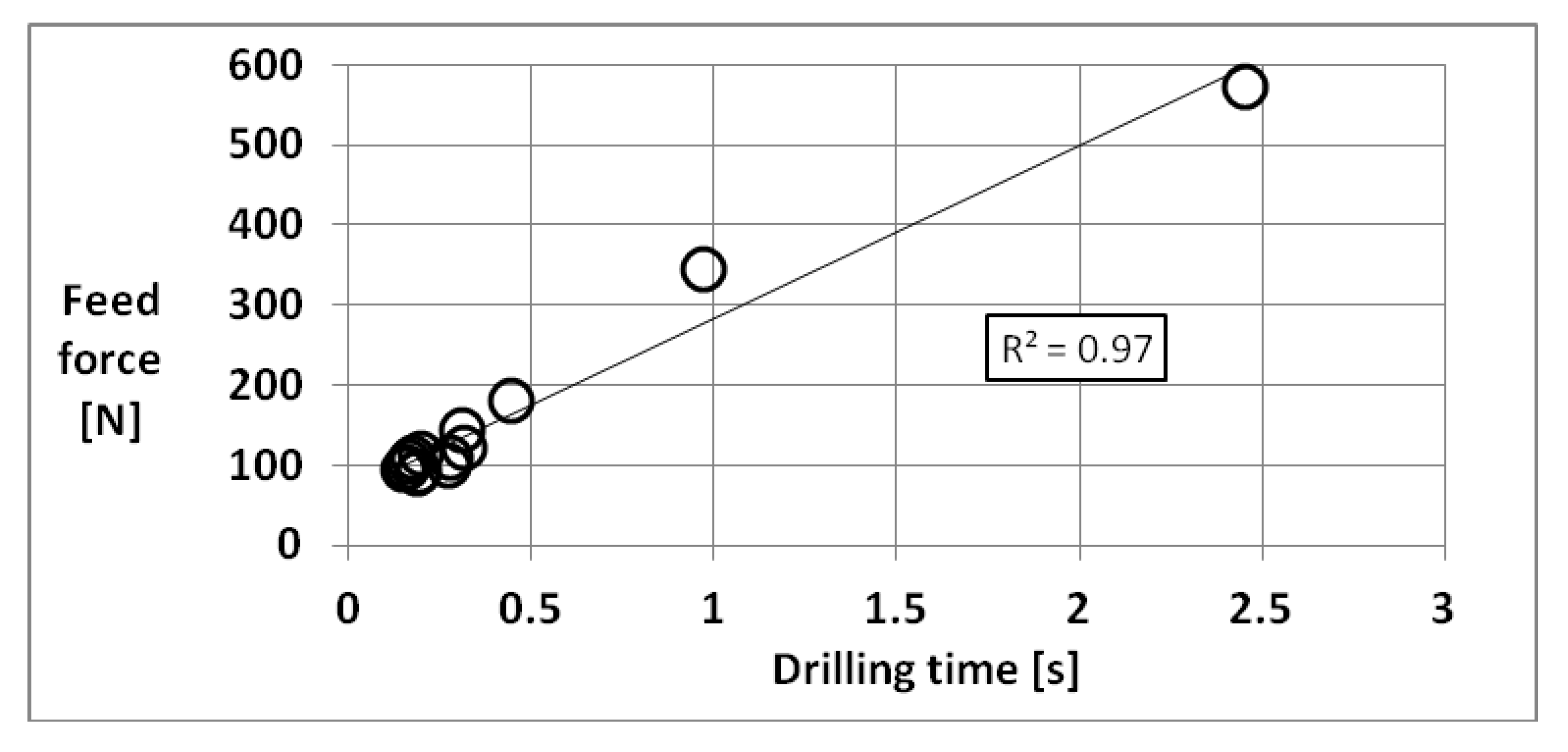
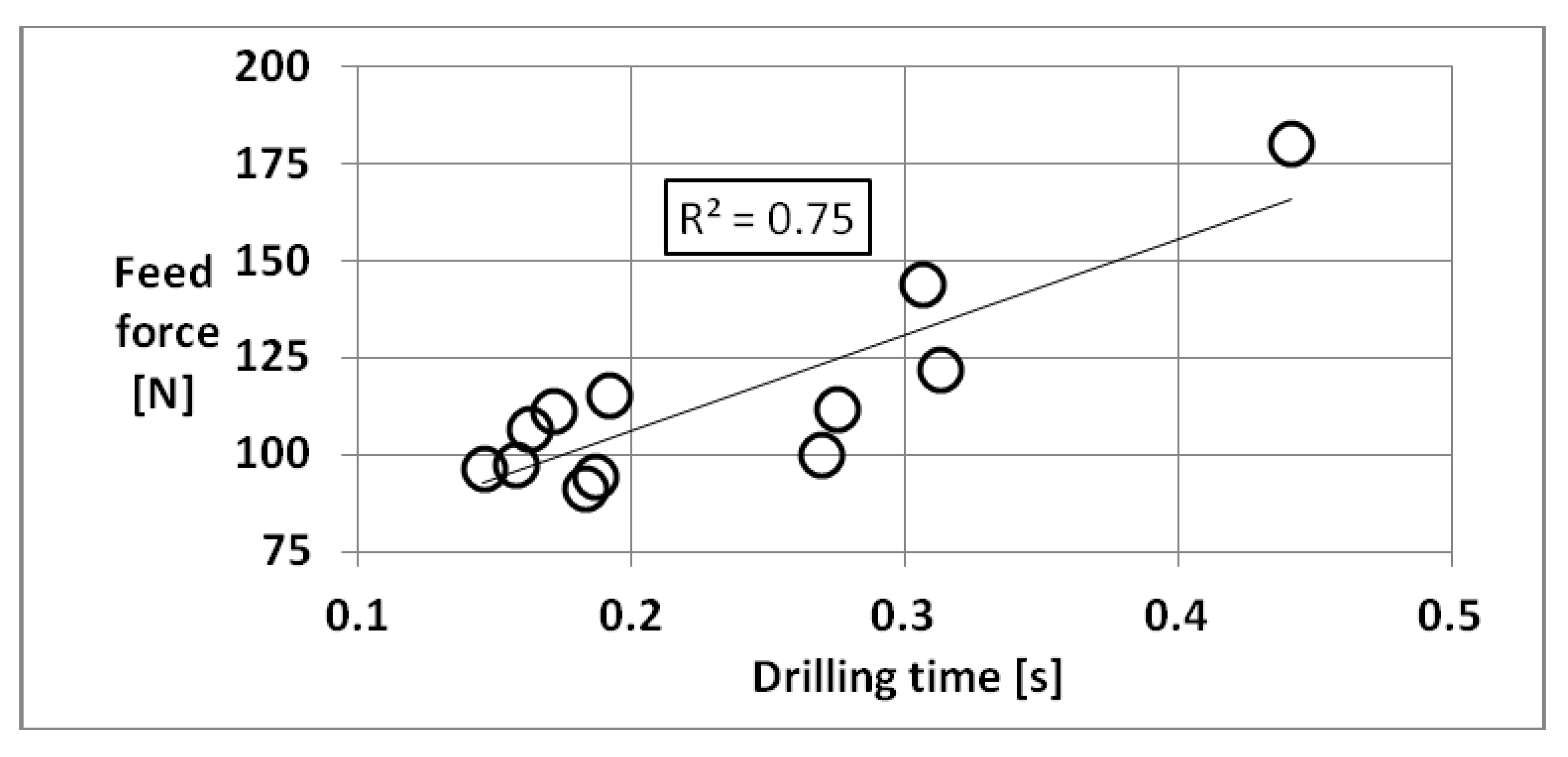
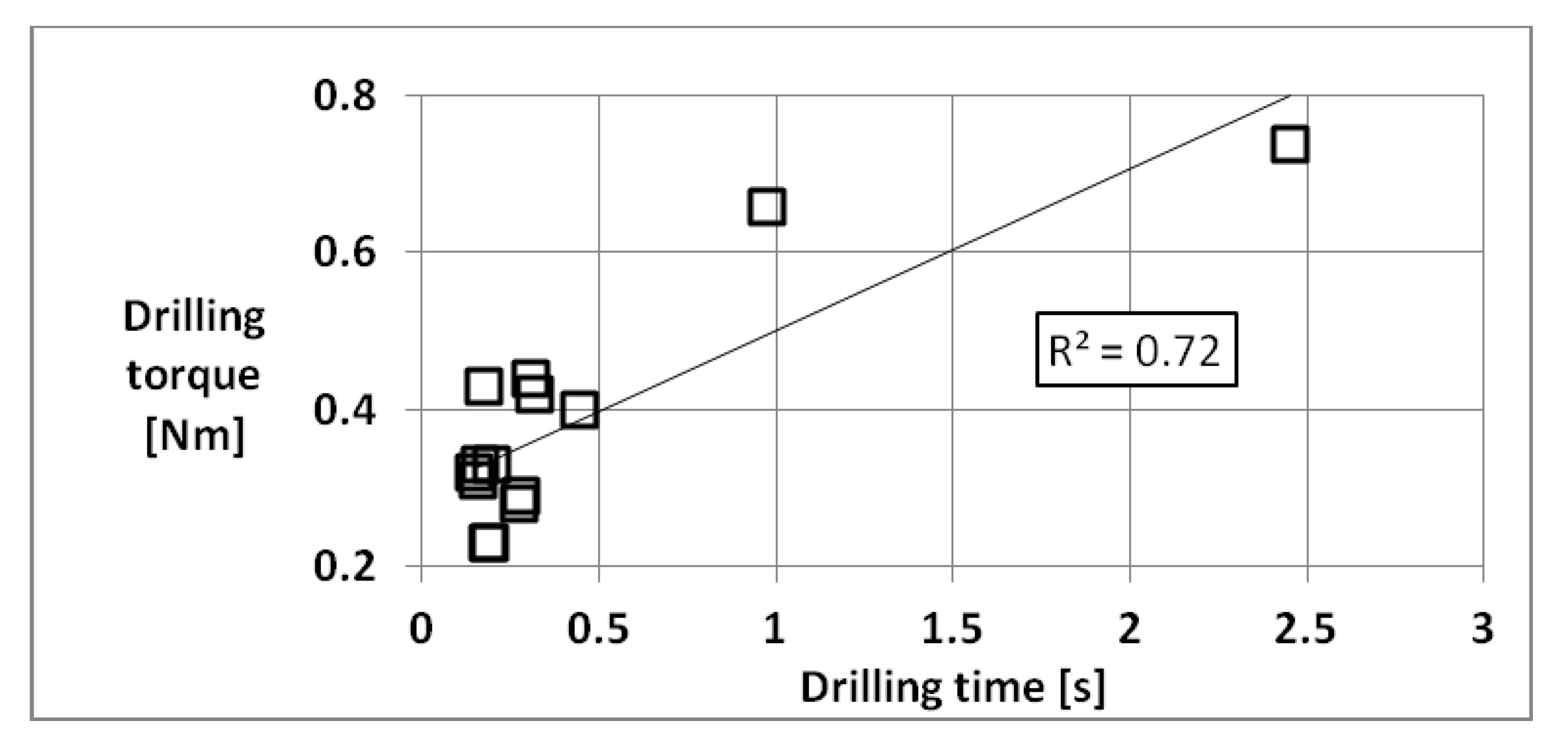


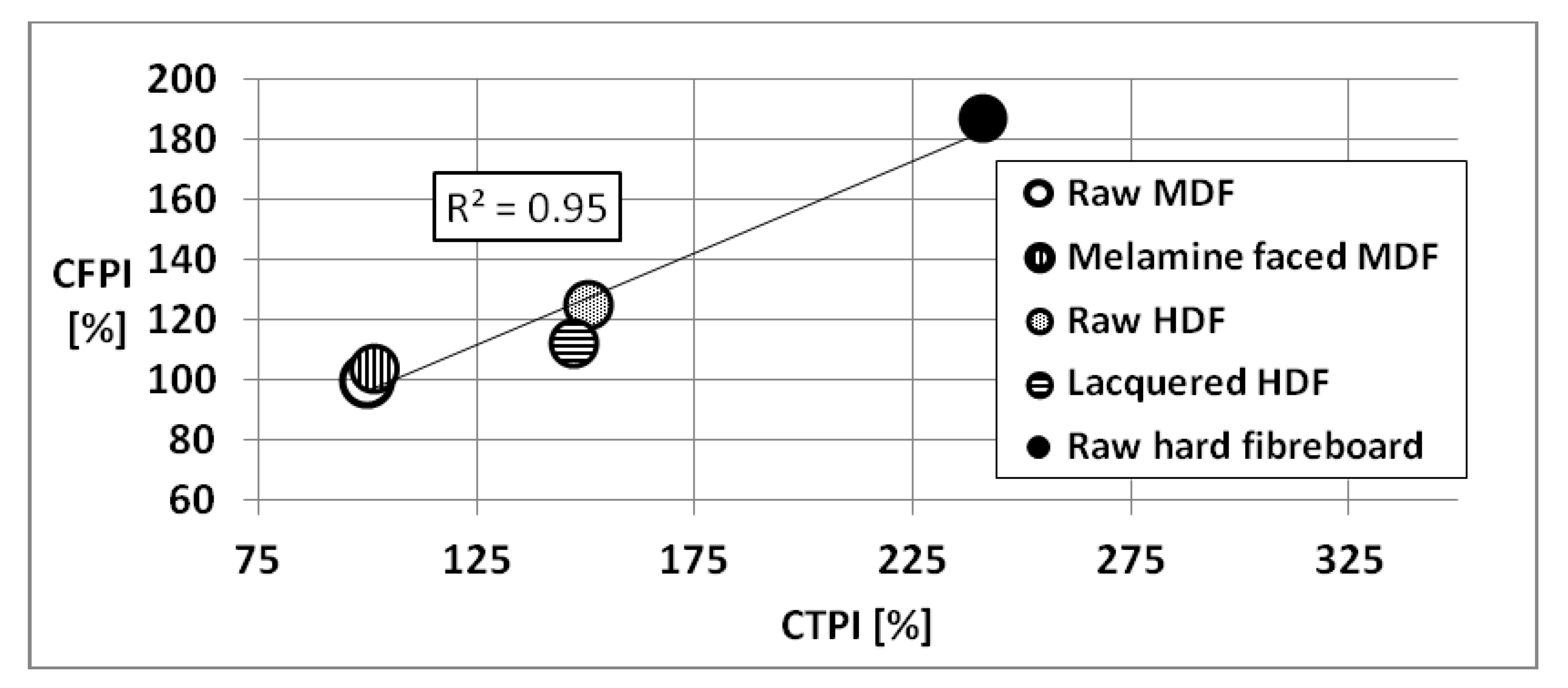
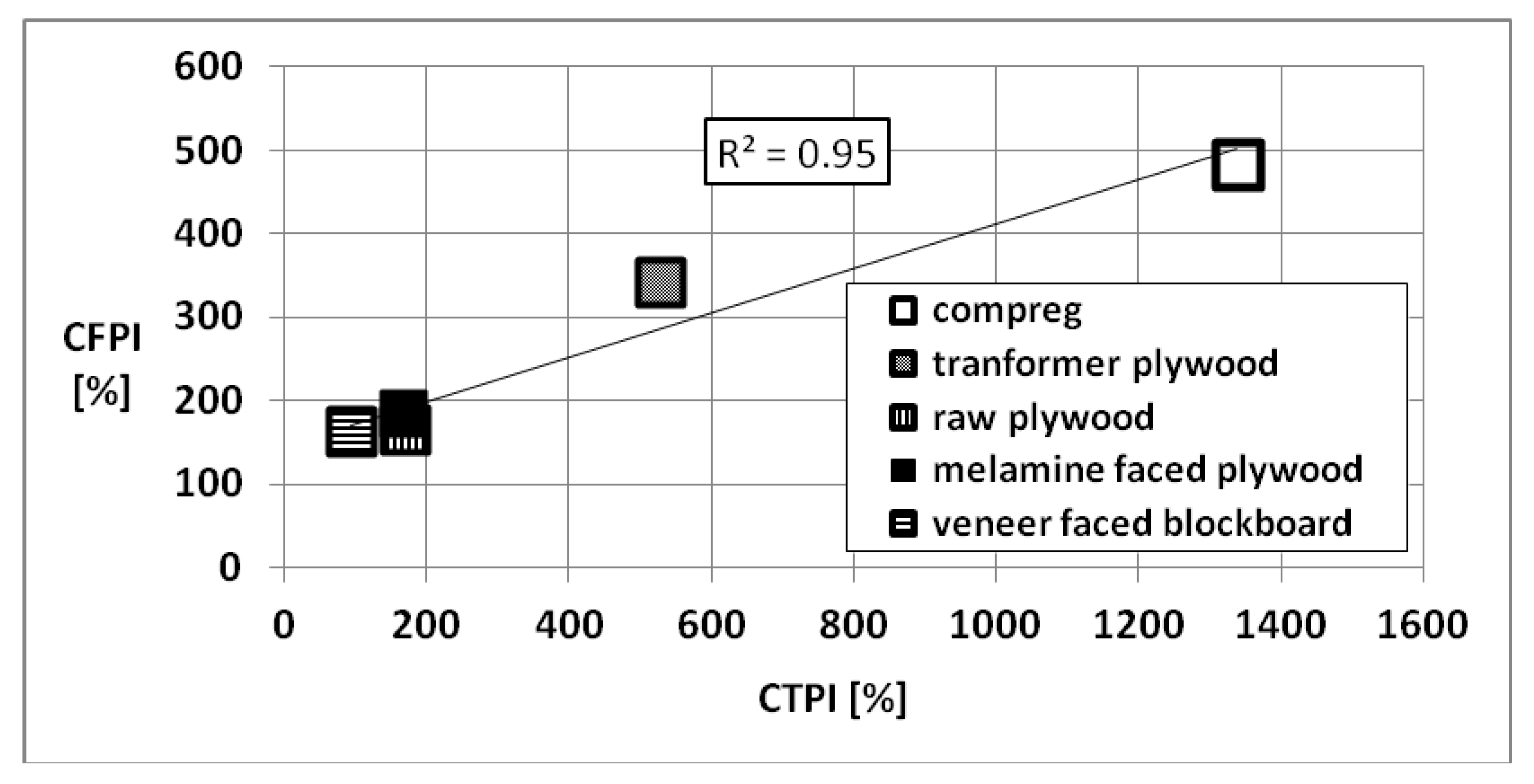
| Density [kg/m3] | Modulus of Rupture (MOR) [N/mm2] | Modulus of Elasticity (MOE) [N/mm2] | Brinell Hardness HB | Main Application | |
|---|---|---|---|---|---|
| Raw MDF | 746 | 33.9 | 4180.0 | 4.0 | Furniture components: frames, doors |
| Melamine faced MDF | 756 | 33.5 | 4231.8 | 5.0 | |
| Raw HDF | 855 | 50.0 | 5495.9 | 5.6 | Furniture components: backs, partitions |
| Lacquered HDF | 801 | 40.5 | 4386.1 | 5.4 | |
| Hard fibreboard | 948 | 40.5 | 4128.4 | 10.1 | Furniture components: backs, drawer bottoms |
| Particleboards P4 | 649 | 13.1 | 3204.4 | 2.6 | Furniture components: upholstered furniture frames |
| Melamine faced particleboard P3 | 666 | 15.4 | 2948.4 | 2.1 | Furniture components: frames, doors |
| Particleboard P5 | 725 | 21.1 | 3802.9 | 4.7 | Furniture industry, construction |
| OSB | 595 | 30.9 | 5490.1 | 4.2 | Building construction, flooring |
| Compreg | 1344 | 137.9 | 12,402.6 | 23.4 | Machine parts, aircraft industry |
| Transformer plywood | 986 | 149.8 | 15,162.2 | 11.4 | Power transformers |
| Raw plywood | 661 | 77.0 | 8292.5 | 2.9 | Construction, packaging |
| Melamine faced plywood | 728 | 42.9 | 5912.3 | 4.1 | Concrete shuttering, flooring |
| Veneer faced blockboard | 586.6 | 52.5 | 5790.4 | 3.1 | Furniture industry: doors and shelving |
| Material | CTPI [%] |
|---|---|
| Raw MDF | 100 |
| Melamine faced MDF | 105 |
| Raw HDF | 191 |
| Lacquered HDF | 171 |
| Raw hard fibreboard | 289 |
| Raw particleboard P4 | 79 |
| Melamine faced particleboard P3 | 88 |
| Raw particleboard P5 | 114 |
| OSB | 83 |
| Compreg | 1545 |
| Tranformer plywood | 633 |
| Raw plywood | 202 |
| Melamine faced plywood | 190 |
| Veneer faced blockboard | 104 |
Publisher’s Note: MDPI stays neutral with regard to jurisdictional claims in published maps and institutional affiliations. |
© 2021 by the authors. Licensee MDPI, Basel, Switzerland. This article is an open access article distributed under the terms and conditions of the Creative Commons Attribution (CC BY) license (https://creativecommons.org/licenses/by/4.0/).
Share and Cite
Podziewski, P.; Śmietańska, K.; Górski, J. Experimental Verification of a Highly Simplified, Preliminary Machinability Test for Wood-Based Boards in the Case of Drilling. Forests 2021, 12, 1334. https://doi.org/10.3390/f12101334
Podziewski P, Śmietańska K, Górski J. Experimental Verification of a Highly Simplified, Preliminary Machinability Test for Wood-Based Boards in the Case of Drilling. Forests. 2021; 12(10):1334. https://doi.org/10.3390/f12101334
Chicago/Turabian StylePodziewski, Piotr, Katarzyna Śmietańska, and Jarosław Górski. 2021. "Experimental Verification of a Highly Simplified, Preliminary Machinability Test for Wood-Based Boards in the Case of Drilling" Forests 12, no. 10: 1334. https://doi.org/10.3390/f12101334





